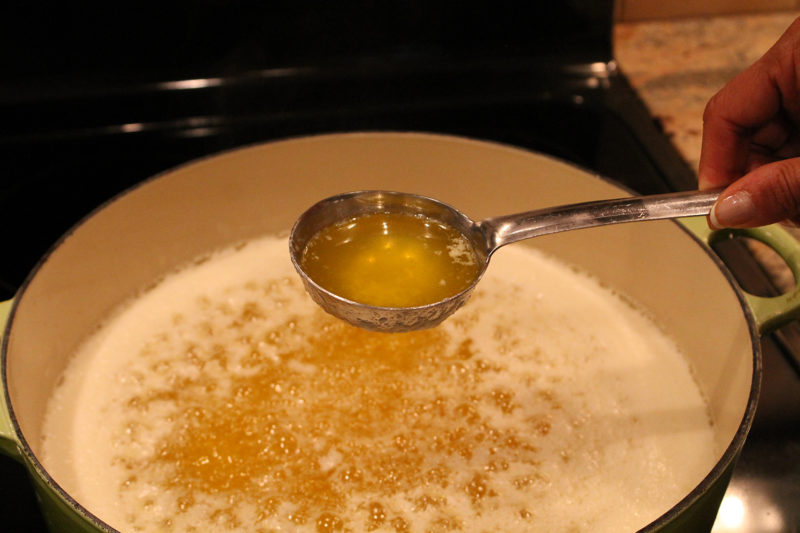Did you know that in ancient times, the wealth of a king was measured the number of cows he owned in his corral? It was called go-dhan, which means cow wealth. While gold was extremely valuable, cows and the land they roamed were equally as important. In villages today, it is common to see cows roam freely, where cars must give them the right of way. Cows are considered sacred all over India. In the state of Rajasthan, to hurt a cow or slaughter it for food is punishable by death. I share some of these enduring tidbits, as food for thought.
In the silence of my kitchen, I meditate to the gentle crackling sound of ghee simmering in the pot. It is such a satisfying sound! I am mesmerized by the alchemy of change happening right before my eyes as the butter is purified by the heat of the stove.
Ghee has always been an integral part of my life, so I included it in my cookbook Turmeric & Spice. Here is an excerpt: “Ghee is traditionally made by heating the unsalted butter made from a cow or buffalo. Today, the best ghee is made from unsalted organic butter that comes from cows allowed to roam free and graze on green pastures. We call them happy cows.”
The journey from milk to ghee starts with cream, which is collected from the milk for a few days. This is mixed and whipped and churned with soured yogurt until the whey separates and the solids become butter. The butter solids are then heated, which transforms the translucent, cloudy color into clear and transparent, revealing the beautiful golden color of ghee. It is no wonder it is called the most refined essence of milk; at this stage, Ayurveda considers ghee dairy-free at this stage, even though it comes from a cow. 
As people have begun to make healthier lifestyle choices, ghee has become more and more popular. It is a great replacement for butter because it does not contain lactose or casein, two components of milk that make butter difficult to digest for some people. “Removing water and milk solids also contributes another added benefit: ghee is shelf-stable and should be stored at room temperature where it remains semi-solid. Do not store ghee in your refrigerator–though many health foods stores stock it in the refrigerated section.” (http://nourishedkitchen.com/ghee-a-wholesome-fat/).
Ghee is a great metaphor for life. We are consistently burnishing and brandishing our souls with all of life’s challenges and events. When things are cool, calm, perfect and going as planned, you do not change a thing. But inevitably, when we are faced with the struggles and the hardships of life, we feel an inner heat, sometimes manifested as frustration, stress, or sometimes as motivation and determination. By going through these experiences that light a fire under us and force us to change, we undergo a purification process. It is the hard, hot, and fiery times in our lives that cause us to reflect, consider our circumstances, and improve ourselves—to purify. Currently, we are all facing a global pandemic that has taken us out of our comfort zones; we have been forced to rethink our way of living and our choices. This has been discomforting because everything we know has been uprooted. It is in the suffering that we suddenly have a new perspective. We analyze, make decisions, and change, which brings about transformation. Just like the heat of the flame under the butter purifies it into something much healthier, we burnish and brandish our lives, striving to make better choices.


